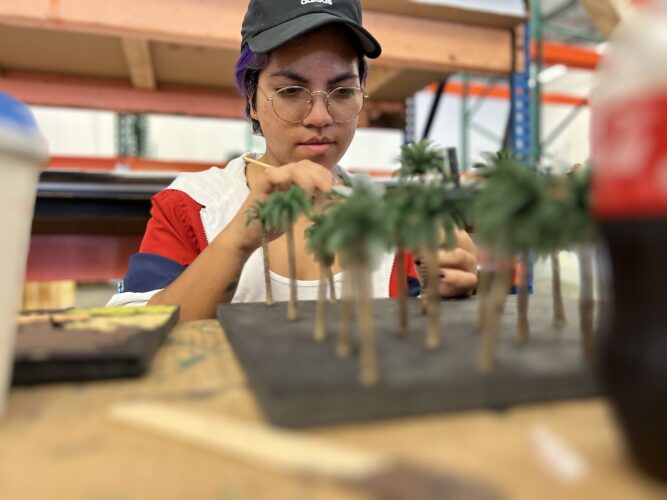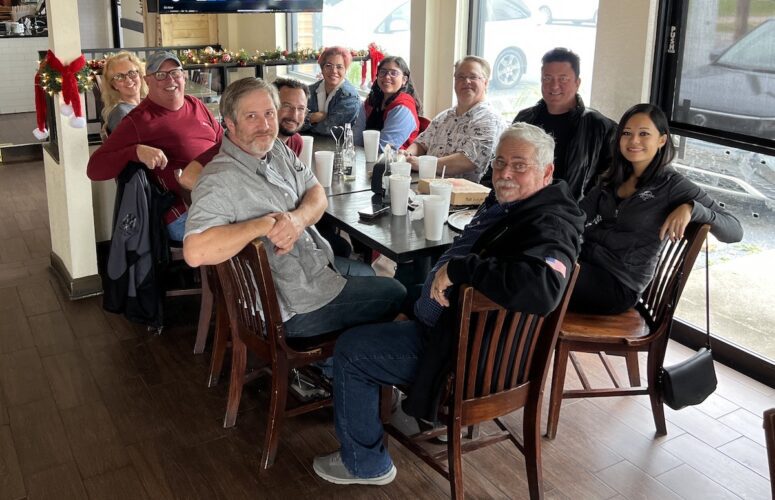What it’s like interning at a theme park scenic design company
As a student, you may have a preconceived idea of what your future may look like, or you may have no idea at all. Regardless, this should be an exciting period of exploration and self discovery. Finding a great internship is a surefire way to try new things and gain experience in the fields you’re interested in. But how do you get such a great opportunity?

By Adriana Hernandez Rosa
I’ll be honest, there isn’t exactly a formula for getting the perfect internship. In my experience, it came down to reaching out to the right person at the right time. Once the door was opened, it became about how well my portfolio demonstrated my potential, and how well I would fit in within the company culture. While part of the process is due to chance, it is important to recognize that you can increase your luck by putting yourself out there, reaching out to people, doing research about the companies you are applying to, and being ready to jump into any opportunity. Just remember to keep your eyes open – your big break may be right around the corner and it may not look the way you expected.
Before I became part of American Scenic Design, Inc. (ASDI), I knew I wanted to work somewhere where I could incorporate both my engineering and animation education. While I didn’t know exactly what I wanted, themed entertainment was one of my most interesting options. After watching Walt Disney Imagineering documentaries and diorama progress videos on YouTube, the world of theme parks and model building became something I aspired to become a part of. Now I’ve found myself in this incredible position where I’ve learned infinitely more about both, the industry, and about myself and my future goals. Below are some of the most fascinating parts of the job and things that I’ve learned along the way.
Style Guides
On my first day at the office, my task was organizing a printed style guide for a high profile Intellectual Property (IP) by binder chapters. The work wasn’t anything too crazy or out of my wheelhouse, but the tasks handed to me started to grow and become more important. A few months later, I was asked if I knew how to use Adobe Indesign; I did. Hence, I was handed another set of style guides, but this time, it was revisions for the client. While the work was tedious, and incorporated a large quantity of small tasks, it also meant there was not a single page that hadn’t been seen through my eyes, and to which I did not have input.
The amount of detail that was involved in specifying the intricacies of a fantasy world was impressive; things you’d never think of, or expect to see were included as guidance for design teams. These details are extremely important to keep organized, and it was this project that taught me the importance of team organization and the magical use of spreadsheets. It was amazing to gain a deeper understanding of IPs that I already loved and connected with as well as team building.

Model Building
The first major project I was put on was a “ride-through” 1”-1” scale white model for an unannounced “E-Ticket” attraction. While working in the model shop, I was tasked with gluing, cutting, and mounting pieces of the model, which was entirely made out of foamcore. I didn’t know that “ride-through” models existed at this point because the most common example of a scaled model is the polished and detailed art director’s model. A “ride-through” model is … well, a model you can literally ride through!
The model itself is placed on table tops that are carved to match the ride path and the spectator is able to sit on a stool and roll themselves through each scene. A white model on the other hand, is not as detailed as an art director’s model, and serves as a tool for the creative team to visualize their concepts in a physical space through general massing and scenic placement.
Most recently, our team got to work on the followup model from that initial white model. We were tasked with creating a detailed and colored 1:1 scaled art director’s model for three scenes within the ride, and painting them in blacklight paint – something which is not as common in this industry. I was lucky to have been able to gain experience with this. It was also through this project that I learned how to carve foam and use a 3D resin printer.
Prop Shopping

A unique experience I was able to participate in was prop shopping. This was so fun because it was treated more as a treasure hunt than as regular shopping; there were specific items to look for that had to match a specific time period and a certain look or material. To do this, we used every resource available: Etsy, Amazon, Google, antique malls and fairs, etc.
The items we couldn’t find or were too specific had to be moved from the purchased props list to the fabricated props list, and had to go to a vendor to be built. The number of items needed was extensive and everything was organized into spreadsheets that tracked our progress and our options. It was beautiful to think of the way all these unlikely items would come together and tell their own story so beautifully when finally placed within the attraction.
There was also material shopping. Here, we were given specific types of foliage that had to match a scene for a scaled art director’s model. This was interesting, because rather than matching something specifically, it was more about finding a representation of a type of plant. This was fun since there was a lot of creative freedom with the way each type of plant was used. What was advertised as a miniature tree may have been taken apart and used as a bush instead; it was more about shapes and textures than anything else. With this also came a guessing game and the need to predict what the art director would want/prefer. At this point, it was more about providing a variety of knowledgeable options with the hope that a majority of them would get approved.
Mockups
Mockups are quite similar to models in the sense that they’re utilized to prove a concept or effect. However, mockups tend to be more focused on a specific technological innovation, special effects, and problem solving within the ride as part of the research and development (R&D) process. While there are small-scale mockups, many of the ones I’ve been able to participate in have been life-sized at full scale. Although, sometimes both are included as part of one project.
For example, to prove a vanishing effect, there was a small-scale, table top mockup built in order to figure out the creative and technical logistics of how the desired effect could be achieved. In a later phase, this same effect was mocked up at full scale with the goal of selecting the appropriate materials, colors and props that would be used in the real attraction installation.
Because of their size, the process of construction involves a great deal of teamwork and requires problem solving. These mockups need to be able to be moved from the manufacturer facility (like American Scenic Design, Inc.) to the client’s presentation space and also have to be taken apart and put back together properly. Hence, why these projects incorporate a great deal of engineering and artistry, which I love.

Photo by Universal Orlando
Theme Parks Before Hours
A unique experience I was able to have through American Scenic Design, Inc. was going to the theme parks “before hours” (before the park opened to the public), which involves visiting the park earlier than most people ever get the chance to. I’ve been to the parks on a normal day, and it tends to be very crowded. Thus, the details that make the lands so immersive get lost and aren’t as noticeable as they are when there is no one else walking about the area.
Being in these lands with just a small team was incredible because every detail was visible. The experience is heightened when you consider that you’re shadowing professionals that know the place inside and out, so you end up learning information and hearing stories that only they know.

Meetings
Part of being an intern is participating in office meetings and gaining a sense of how the business as a whole is organized. I find it really interesting and useful to know what types of projects are going on in the office because that way I am able to offer help and ask for work where it is needed the most. It is also super fun to see your name under a specific task.
Other types of meetings include our meetings with partner companies or clients. For example, one of our head designers visits the fabrication shop and provides their art direction and notes on what is being built. It’s in these review meetings where changes are made and discussions on what’s next are had. As an intern, it’s super exciting to take in each step of the process, learn where everything comes from, and understand the amount of collaboration and hard work that it takes to put such a massive project together.
Conclusion
In short, being an intern at American Scenic Design, Inc. is a ton of fun. The company makes it a point for all interns to learn and take part in a variety of tasks and projects, which makes for a remarkable learning experience.
The best advice I can give is to put yourself out there, go to industry conventions or mixers, talk to people, and be nice. Many times I’ve been told the most important thing that turns a person into a great coworker is their personal skills and a positive attitude. So just relax, reach out to those you look up to, and gain skills in as many disciplines as you can.

